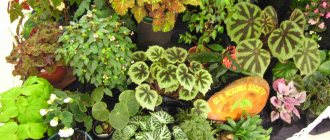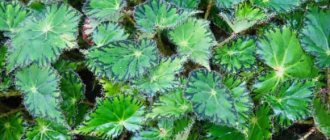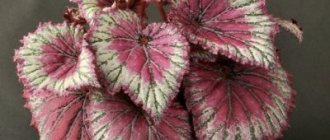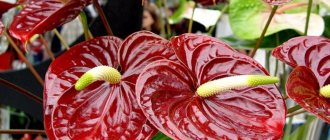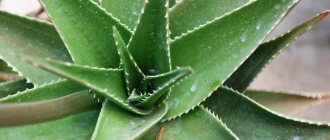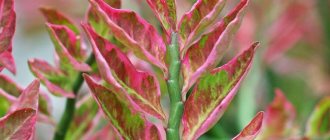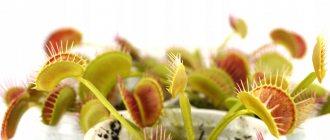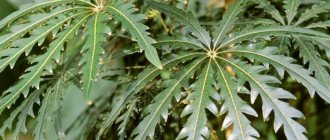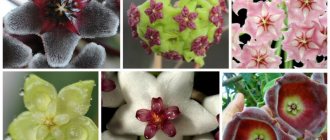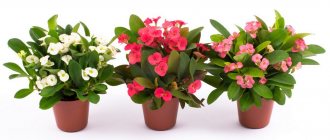Features of begonia eliator
Begonia is an ornamental plant that is a perennial. In nature, it is found in the highlands of tropical hot forests. This plant has a characteristic feature - a pronounced asymmetry of the leaf plates. The flowers of this plant are lush and highly decorative. This plant is cultivated both indoors and in the garden.
The genus received its name in honor of its discoverer, Begon. Under natural conditions, this plant was found in South America, India and Africa. Begonia was first discovered and described in the Antilles. At the moment, there are only 6 species of this plant, but thanks to the efforts of breeders, more than one thousand different varieties have appeared. But among all this diversity there are no tall and medium-growing varieties. The bushes are quite low, and therefore they are most often used to decorate rooms. This ornamental plant is also often used as a climbing plant. Begonia eliator is a spectacular bush with lush flowers. This explains the high popularity of this plant.
Scientists have found that such a flower is capable of purifying the air from pathogenic microbes. It releases phytoncides that most effectively fight staphylococcus. It is because of this that you can increasingly see begonia in kindergartens and medical institutions.
The most vigorous varieties of this plant reach a height of 25 to 37 centimeters. Medium-sized varieties include those varieties whose height varies from 15 to 18 centimeters. Low-growing bushes have a height of only 8–15 centimeters. Breeders managed to develop varieties:
- with bushy structure;
- with upright shoots;
- with climbing stems.
Even a variety has been bred that can bloom all year round, but in mid-latitudes it cannot be cultivated in open ground. This plant needs warmth throughout the year.
Begonia is divided into three main categories:
- bush - has no pronounced specificity;
- foliage-decorative - leaf plates are medium or large, and they are decorated with wide stripes;
- tuberous - in this group, representatives differ from each other only in flowers and shoots.
Interestingly, this plant is capable of forming a different root system. And what kind of root system the bush will have depends on the growing conditions. For example, when begonia is grown outdoors, it forms tubers. A bush growing indoors develops fibrous or rhizomatous roots. Those specimens that form tubers grow the most powerful and tall shoots. And flowers with fibrous or rhizomatous root systems are ideal for planting in decorative baskets.
My BEGONIA ELATIOR and others.
About the plant
The plant is a perennial shrub, of a hybrid type. The maximum height reaches no more than 40cm. The stem is strong and fleshy. Flowers are usually up to 8 cm in diameter, collected in inflorescences. They are placed on long peduncles.
The color of the petals varies, depending on the variety. The texture of the inflorescences is terry and smooth. The type of flowers resembles a little inflorescence of roses and peonies. The leaves have an asymmetrical, heart-shaped shape.
Their color is dark green with a glossy sheen; underneath they are light green. The main feature of this species is flowering in the cold season, for this quality the plant is given the second name “winter”.
Caring for begonia elatior at home
Illumination
In order for begonia elatior to bloom luxuriantly and develop well, it needs a large amount of bright sunlight, but it must be diffused. Window sills of western or eastern orientation are best suited for such a flower. The fact is that on a southern window, due to excessively bright lighting, burns may form on the surface of the foliage, and the northern window sill is not suitable because there is very little light there. Remember that light shade is best for this crop.
In cold times, when the sun no longer shines so brightly, begonia can develop well only with the use of additional lighting. Remember that the bush should be accustomed to brighter lighting gradually, otherwise burns may form on its foliage, which has an extremely negative effect on the decorative appearance of the plant. And if the plant is still young and fragile, then a rapid increase in illumination can cause its death.
Temperature
An air temperature of 21–25 degrees is ideal for such begonia. Please note that it must be kept warm at all times. If the bush stays in the cold even for a short time, it can suffer greatly. In this regard, protect the flower from exposure to low temperatures.
Cold drafts can also seriously harm the plant, and the temperature difference can be very small (2–3 degrees).
Transfer
Experienced flower growers advise replanting begonia only when it is no longer possible to do without it. If you just bought a flower in a store, then take replanting it seriously, and take into account all the requirements and recommendations. In this case, you will be able to avoid replanting an adult bush in the future. Please note that the root system of begonias is very sensitive, and even if it receives minor damage during transplantation, this can lead to the death of the flower.
A bush purchased in a store should be transplanted from a shipping container to a permanent one only after it has completely flowered. But sometimes it happens that you have to replant begonia earlier than recommended by experts. In this case, even greater care and caution should be exercised. Step-by-step description of the transplant procedure:
- When there are 4 to 6 hours left before transplanting, be sure to thoroughly water the substrate in the flower pot.
- Take a new pot and make a good layer of drainage at the bottom. For this, it is recommended to use sphagnum moss mixed with expanded clay.
- Then the drainage layer is covered with a small layer of pre-prepared soil mixture. Please note that even if you bought the substrate in a store, it still needs to be disinfected, for example, calcined in the oven. The layer of soil mixture should be such that after replanting the bush is in the new container at the same level as in the old pot.
- Begonia is replanted using the transshipment method. To do this, the flower is very carefully removed from the old container, trying to keep the earthen lump as intact as possible.
- Place the plant in a new pot and carefully fill any voids with fresh soil mixture.
- Compact the surface of the substrate and water the bush. There is no need to water the plant too much.
Please note that even if you replant the bush very carefully, it will still hurt for a long time. Therefore, before the transplant you need to think carefully again; you may be able to do without this procedure.
Begonia elatior: selection, care, reproduction
Fertilizer
They begin to feed this crop only when the first buds form on the bush. Moreover, you do not need to wait until the entire bush is covered with flowers; it is recommended to apply fertilizer at the beginning of the budding period. It is best to use complex fertilizer in liquid form for fertilizing. It is mixed with water for irrigation once every 10 days and carefully poured under the root of the flower. Systematic fertilizing allows you to achieve more abundant and spectacular flowering.
In winter, after the bush has completely faded, it is strictly forbidden to feed it. Because of this, the plant's dormancy may be disturbed. And sometimes feeding during the dormant period leads to its death.
You can feed the plant with a mixture of potassium and phosphorus. And this feeding is carried out once every 2 weeks, immediately after the start of flowering. Experts say that thanks to this fertilizing, the decorative value of the plant during the flowering period increases, and it looks healthier.
How to water
Watering is an important part of caring for indoor begonias. In order for it to feel good and develop within normal limits, you need to monitor the humidity of the substrate in the pot, which should be optimal. Also make sure that liquid in the soil mixture does not stagnate under any circumstances, as this can have an extremely negative effect on the condition of the flower. It should be noted that stagnation of liquid in a pot is dangerous for the plant at any time of the year.
In summer, the bush is watered more abundantly. If at this time he feels a lack of water, this will negatively affect his development. After watering, make sure that all excess liquid flows into the pan, from which it must be poured.
Experienced flower growers are confident that watering must be carried out at a certain time. For example, if today you water a bush in the afternoon, and next time in the morning, then it will not be able to adjust well to the upcoming watering. Therefore, you need to water the flower strictly at the same time (an error of a quarter of an hour is allowed).
In the warm season, begonia elatior is watered at least once every three days. On particularly hot days, watering is carried out immediately after the top layer of soil mixture in the pot dries. After the autumn period arrives, the amount of watering should be reduced. With the onset of the cold season, begonia begins a dormant period. During this period, you need to water the bush even less often.
The dormant period of this flower does not end with the onset of calendar spring or after an increase in daylight hours. Only after warm weather sets in outside, the bush is “awakened” by gradually increasing the frequency and abundance of watering.
For irrigation, you can only use water whose temperature is slightly above room temperature. If desired, you can use pre-boiled water. Pour the liquid into the pot very carefully to avoid washing out the soil mixture.
Trimming
As a rule, gardeners try to keep the begonia bush compact and lush. To achieve this, you should pinch off the top. Thanks to this, the growth of side shoots and young foliage is activated. Pinching the tops is necessary in the spring. And if during the growing season you notice that the stems have become very elongated, then their tops are also pinched.
Despite the fact that begonia is a perennial, it ages very quickly and loses its decorative effect. Do not forget to regularly clean the bush of fading flowers and old leaf blades. If this rule is neglected, it will not only negatively affect the decorative appearance of the bush, but will also weaken it, since unnecessary flowers and leaves will draw water and nutrients from it. In order to better ventilate the surface of the substrate, it is recommended to remove some of the lower leaves.
Experienced flower growers advise that it is imperative to think through a scheme for forming a bush while it is still very young. After the stem reaches a height of 60–70 mm, be sure to pinch off its upper part, in which case the formation of side shoots will significantly improve. After the time has come, a gradual reduction in the frequency and abundance of watering is carried out. Before the growing season begins, try to provide the flower with suitable conditions and good care.
The tops of the side shoots are pinched immediately after their height reaches 10 centimeters. However, do not pinch shoots under or at the same level as the outward-facing bud.
This is the formation of young bushes. With further care, all you have to do is, if necessary, shorten excessively long shoots and remove dried stems.
Bloom
Growing in warmth and receiving proper care, begonia blooms magnificently and for a very long time. But this is only possible if all female buds are removed at the very beginning of budding.
The elegant and very spectacular flowers of this plant are similar in appearance to a rose or carnation. In order for the bush to bloom systematically, you need to:
- rejuvenate it in a timely manner;
- if necessary, transplant it into a new pot;
- replace the substrate with a new one (this allows you to get rid of rotting particles of rhizome remaining in the soil mixture).
Soil selection
Begonias love loose soil with low acidity. The soil should be as saturated with nutrients as possible, so it is better to purchase it in a specialized store. If you prepare the soil manually, sterilize it before planting indoor exotics. This is necessary to exclude the presence of pathogenic bacteria. It is important that the soil is moderately moist. Begonia categorically does not tolerate waterlogging, this leads to rotting of the roots.
Photo: Before planting begonia, the soil must be saturated with nutrients
Reproduction methods
Growing from seeds
Begonia elatior can be propagated by seed. December is best for sowing seeds, but if absolutely necessary, it can be done in the second half of autumn. The seed material of this plant is highly susceptible to adverse factors, so it is not recommended to add additional substrates to the soil for sowing.
Experts advise buying seed material at a flower shop and it is better if it is granulated, as it is much easier to work with. Soak the seeds for 30–45 minutes. in a pinkish solution of potassium permanganate, rinse in clean water and plant in pre-moistened peat tablets. The tablets are placed in a tray and covered with film or glass on top. Do not forget to regularly pour clean water into the pan. Remember that the tablets should be slightly damp at all times. Also, crops must be kept warm (20–22 degrees).
As a rule, the first seedlings appear 2–3 weeks after sowing. The plants are planted in separate pots when their third true leaf blade appears. They are picked for the second time around the eighth week of growth. The strengthened seedlings are planted in separate pots and gradually accustomed to sunlight. To begin with, they are placed on a well-lit windowsill only in the morning.
Propagation by leaf or cuttings
To harvest cuttings or leaves necessary for propagation, use an absolutely healthy, strong and mature bush. It should reach a height of at least 12 centimeters. Root the stem or leaf cuttings in a peat or sandy substrate. Remember to keep the substrate slightly moist. To accelerate the emergence of roots, phytohormones are used.
Begonia Elatior. Propagation of begonia elatior by leaves and cuttings.
Possible mistakes
In conclusion, let us dwell on the list of the most common mistakes when propagating ficus by cuttings.
The cuttings rotted in the water. Most often, the reason is that you have “worn out” the stem - damaged tissues very quickly succumb to various diseases.
- The cuttings rotted in the ground. This usually happens when there is overwatering. For complete root formation, the plant needs not only water, but also air. It is practically absent in the swampy substrate; accordingly, the conditions necessary for the successful propagation of ficus are not maintained.
- The cutting does not take root for a long time. You need to cut the cutting right under the bud. The fact is that plants have their own “instinct of self-preservation” - the ficus tries to protect its bud and therefore devotes all its strength to growing roots near it. If you leave a small section of the stem under it, then it will remain a supply of useful microelements, which will be enough to maintain the bud for a long time. In this case, you have to wait a very long time for the roots to appear.
It should be noted that regardless of whether you root cuttings in water or in soil, rot can result from low temperatures. The optimal condition for the growth of full-fledged roots is considered to be a temperature of at least 22 degrees, so if you carry out work in the winter, place a sheet of foam plastic under the container with the shoots. It will protect the young plant from a too cold window sill.
With the creation of root formation stimulants, propagation by cuttings at home has become much easier, but there are some subtleties here too. “Kornevin” and other drugs of similar action should be used strictly according to the instructions: an overdose, even the slightest, leads to exactly the opposite effect. There are known cases when the ficus had already given roots, the delighted grower added another dose of the composition to the container, expecting that the growth of a new ficus would go faster, but instead the plants died.
The following video will tell you more about propagating ficus at home.
Diseases and pests
Diseases
Begonia elatior can develop powdery mildew. In this case, very small light-colored spots form on the surface of its foliage. There is a gradual darkening of the leaves and their drying out. You can treat the bush with a solution of tar soap (20 grams per 1 liter of water) or copper sulfate (2 grams per 1 liter of water). You can also use a solution of a fungicidal drug.
If whitish spots with a slight grayish coating appear on the bush, this means that it is affected by gray rot. The spots gradually darken and become brown and moist. Treat the diseased bush with a solution of Bordeaux mixture (1%) or any fungicidal preparation.
If the plant is affected by bacterial or ring spot, then it must be destroyed and the pot thoroughly disinfected.
Pests
If a false scale insect settles on a begonia, it will begin to weaken and bloom sparingly. The foliage becomes faded and deformed. You can get rid of this pest by treating it with garlic infusion (spray the flower once every 15 days).
To get rid of aphids, the flower is sprayed with a solution of shag infusion (two percent). Moreover, the infusion needs to be kept for two days. You can also use a two to three percent solution of laundry soap. You can also treat the bush with an insecticidal agent.
Transfer
It is permissible to replant the bush after flowering has completed. The soil is changed annually upon reaching the age of four, then the flower does not need it. Begonia rhizomes feel comfortable in small containers (they quickly fill the light soil of the pot); a large pot is not needed.
There should be holes at the bottom of the container for moisture to escape. The lowest layer is drainage; sphagnum or similar material is preferred. Next in line, calcined earth is poured.
Changing a pot for begonia Elatior
The last step is to transplant the clod of earth with the roots of the plant. The free space around it is filled with earth.
Note! When transplanting, accuracy is important. Begonia roots are fragile and sensitive; damage to the underground part will affect the growth and development of flowers.
Types of begonia elatior with photos
Borias
Among all varieties of begonia elatior, the Borias variety stands out. It is one of the highly ornamental plants, and at the same time it is characterized by low requirements for care and growing conditions. The bush blooms every six months and this is quite unusual for such a plant. The second time the bush is covered with flowers is in the cold season, and at this time most other indoor plants experience a dormant period. However, in order for the bush to bloom twice a year, it should be provided with proper care.
The height of the plant of this variety reaches no more than 40 centimeters. Thick shoots are decorated with heart-shaped leaf plates of asymmetrical shape. The color of the front surface of the foliage is bright green, and the back surface is pale green and the veins are clearly visible on it. Flowers can be regular or double; as a rule, they are painted in 2 different color shades.
Charisma
The varietal group of begonia “Charisma” also stands out. It contains only low-growing varieties with glossy green leaves. During flowering, very spectacular double inflorescences are formed, which can be colored in dark salmon, salmon pink, dark pink and reddish-orange.
Baladin
The height of the bush of this plant can reach about 30 centimeters. A distinctive feature of this variety is that it blooms very luxuriantly (up to seventy flowers can open on one bush). And all these flowers can be painted in different shades, for example: red, carmine red and pale pink. That is why this variety is often called “Bouquet in a Pot.” Remember that you should not touch the flowers, as this may cause staining of the skin of your hands.
Annabelle
This variety has bushes of medium height. The yellow showy flowers are double. This flower is perfect for cultivation both in the garden and at home. Flowering is long (from November to July).
Azothus
The bush itself is small in size, and can only be grown at home. However, during flowering, spectacular and rather large double flowers of a pink hue open on it.
Bellona
The stems of this plant reach a height of about 40 centimeters. During flowering, they are decorated with flowers of a rich red hue. This variety can only be cultivated indoors.
Kyoto
This variety grows well only in indoor conditions, so it cannot be grown in the garden. During the flowering period, large white flowers open on the bush.
Renaissance
This vigorous plant can reach a height of about 60 centimeters. Terry inflorescences are red in color.
Berseba
This variety, distinguished by its high decorative value, stands out among the others for its lush flowering. The bushes grow very well at room temperature. However, they are very demanding on lighting, which must be bright.
Mix
This variety is very popular among gardeners. But before you decorate your home with it, you need to take into account that such a plant is characterized by increased demands on growing conditions and care. If you make even minor mistakes in caring for such a begonia, this can lead to unpleasant consequences.
Characteristics of the flower
- Type of plant: ornamental.
- Flower color: pink, red, yellow, white.
- Leaf color: green.
- Sun requirement: partial shade.
- Size: up to 37 cm.
- Flowering: up to twice a year.
- Aroma: no aroma.
To summarize, it should be noted that caring for Elatior begonia is not difficult and if certain rules are followed (proper watering, selection of soil, pot, fertilizers, as well as compliance with temperature and air humidity), the plant will bloom beautifully and for a long time, delighting its owner .
The flower can also be easily propagated in various ways (using leaves, cuttings and seeds), which will allow you to grow several more of the same specimens from one plant.
Reviews from flower growers
Unlike other species, begonia elatior is quite unpretentious. But still, low humidity in the room and draft can greatly harm it. Florists have noticed that even in the second and subsequent years of life, the growth of the bush does not stop, which is an undoubted advantage of this species. But in order for the bush to always look neat, you need to cut out old foliage and shoots in a timely manner. In winter, it is extremely difficult to create optimal conditions for the flower, and its leaves often rust. However, this begonia is perfect for both the garden and the home.
How to grow begonia Elatior
Varieties
In addition to this classification, there are several more varieties of begonia elatior, most often cultivated at home:
- variety Baladin, which, thanks to its peduncles of different heights, creates the appearance of a multi-tiered bouquet, from a distance reminiscent of a bouquet of roses planted in a pot;
- English variety Borias, distinguished by large coral and pink flowers, is even more reminiscent of roses, but blooms longer and more luxuriantly;
- a native of Southeast Asia - Grace variety, growing no higher than 35 cm, is covered with a powerful cap of red flowers that bloom repeatedly throughout the year and do not fade for 2-3 months.
General information:
Begonia elatior
- or winter Begonia, Fireball, a herbaceous plant that belongs to the Begoniaceae family. There are a sufficient number of species of this flower.
It blooms for a long period of time, almost the whole year. The plant appeared relatively recently and became a hybrid among other Begonias. The flower has a variety of colors: yellow, orange, white, pink, red. The root is not big. Begonia elatior has green leaves and beautiful flowers.
For Begonia elatior, you need to select normal temperature conditions for growth. Since with any deviations from the recommended ones, the flower may die, wither or dry out. In no case does it tolerate drafts, we provide good lighting and temperature for normal wintering. If these conditions are not met, the plant may not survive until spring.
